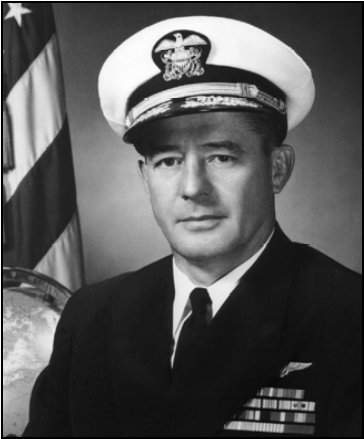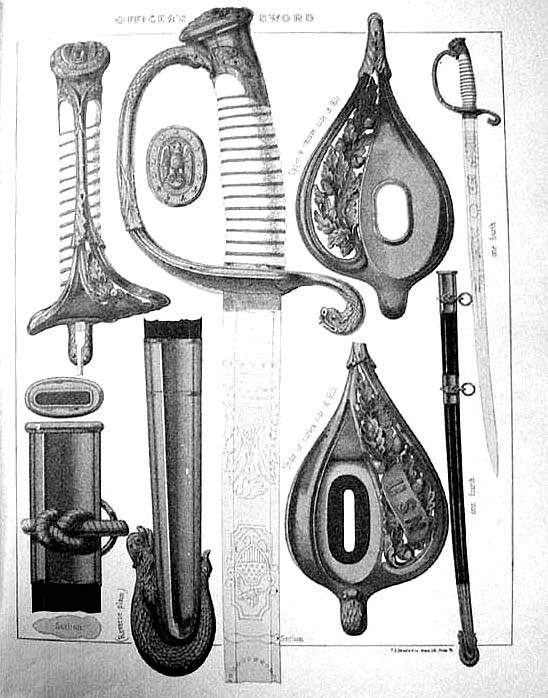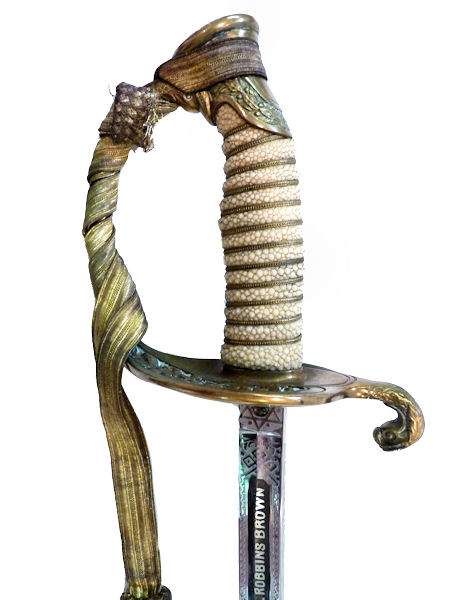Navy M1852 Named Rear Admiral’s Officers Sword WW II Mint
U.S. NAVY REAR ADMIRAL’S OFFICER’S
SWORD Model 1852
Gold Bullion sword knot included

Awarded Distinguished
Flying Cross &
Air Medal for WW II Combat
Presented is an M1852 sword which is named to Samuel Robbins Brown,
a graduate of the U.S. Naval Academy in 1934. As a Lieutenant on June 6, 1942, he was awarded the Distinguished
Flying Cross for action against Japanese enemy forces while serving as an air controller directing carrier-based
bombers in the sinking of an enemy cruiser and destroyer. In December 1942, he also was awarded the Air Medal for completing
five successful missions against Japanese forces. During WW II, the Navy DFC was the fourth highest medal awarded for
heroism or extraordinary achievement in aerial flight behind the Congressional Medal of Honor, Navy Cross, and Silver
Star.
This sword’s blade is approximately 1/4 inch wider than contemporary swords of this same model. The gold
bullion sword knot, or Portepee, is included. The knot weighs 38 grams or 1.22 Troy ounces.

USN and oak leaves on the front guard

Oak leaves on rear guard
 Having participated in action at Pearl Harbor on December 7, 1941, in the Battles of the Coral Sea and Midway Island, and
Having participated in action at Pearl Harbor on December 7, 1941, in the Battles of the Coral Sea and Midway Island, and
in the Solomon Islands and at Santa Cruz, he returned to the United States as head of Aviation Training at Naval Air Station,
Miami. He returned to the Pacific in Command of Carrier Air Group Four (CAG-4) in January 1945 and in January 1946 was transferred
to command CAG-14. He continued to progress in rank and responsibility and held the position of the commanding officer of USS ORCA
(AVP-49) June 1957- June 1958; then CO of USS Forrestal (CVA-59) May 1959 until June 1960; Promoted to Rear Admiral
in 1960, he served in various senior staff assignments until August 1963 when he assumed command of Carrier Division FOUR.
Then back to Washington in 1965 to the Office of Vice Chief of Naval Operations when in October 1965, he was designated, Assistant
Deputy Chief of Naval Operations ( Fleet Operations and Readiness) from which he retired. He married the former Ann
Banning McFarland of Pasadena, CA in June 1940, and died in 1991, his wife and four children surviving.
DIMENSIONS: Blade: 3/4 inch wide, 1/8 inch thick, 30 1/2 inches
long, Handle 5 1/4 inches long. Length overall 35 inches. In scabbard 35 7/8 inches.
Fuller 16 1/2” x 1/2“
Weight sword 2 Lbs 1 1/4 oz
Sword Knot 38 grams or 1.22 Troy ounces
CONDITION:
The leather scabbard is original, and like the sword, is in fine condition. The metal work on the grip, pommel, and
cross guard, and scabbard are exceptional with sharp and even edges. The three strands of wire
wraps over the ray skin cover of the grip tightly. Most of the gilding seems to be worn away due
to repeated polishing now replaced with a pleasing patina of age. This sword speaks of the quality of a bygone era.
The design on the blade is nickel-plated over an acid-etched design
which has only a very few tiny pit spots. There is no need to mention them except for the most discriminating since it is
in Near New Condition overall. The country of origin began to appear on blades starting in 1892. In this case,
Germany is marked on the upper edge.
There are twelve wraps of three-strand wire
on the white ray skin covering the grip. The single fuller is 16 1/2 inches. There are 16 stars on
the blade’s oval and 14 on the pommel. The number of stars in the 1852 design was 13.
In addition to the country of origin, the first is etched on the blade.
It is an oval of sixteen stars. Thirteen stars are what was called for by the official 1852 blade design. Later
M 1852 swords with 5/8″ blades that we inspected have the same oval, but the count is sixteen stars. The dolphin on the
drag is mounted with its head on the side away from the hangers per the official design while the eagle on the pommel
faces right surrounded by 13 stars.


The only difference between the original Model 1852 sword design shown on the left, and that
authorized today, is that in some today, materials such as plastic instead of fish and ray skin, and lower quality
metalwork is being used. Not so with this sword that conforms with the original specifications except that the blade was
decreased in width as follows:
From 1 1/8 inches to about 1 inch after 1872
To about 3/4 inch in the later 19th Century, To 5/8 inch in today’s Navy. The regulation of 1852 had the eagle on the pommel facing right when viewed from behind. The
use of the officer’s sword was suspended on 15 October 1942 and was not authorized officially again until 1954. Source Naval Historical and Heritage Command.
 Finely crafted guard with bullion sword
Finely crafted guard with bullion swordknot
 Initials with dent
Initials with dentunder letter “B“
 Hilt with heavy brass chasing of very high quality
Hilt with heavy brass chasing of very high quality


